Mention Danish food to any gastronome and Noma will surely find its way into the conversation. Over the last decade, the enormous success of this restaurant in Copenhagen, Denmark has put Danish cuisine on the culinary map.
Thanks to the success of Noma and high-profile Danish chefs like René Redzepi, the New Nordic Cuisine movement has become synonymous with Danish food. Beautifully-presented dishes made with the freshest seasonal ingredients is often the first thing people think of when they think of Danish cuisine.
But what about traditional Danish foods? The foundation for this new culinary movement seems to be getting lost in the excitement of reinventing the old!
As appealing as New Nordic Cuisine may be, traditional Danish cooking remains just as interesting, especially for people experiencing it for the first time. To highlight those recipes, we’ve compiled this list of twelve classic Danish dishes to look for on your next trip to Copenhagen.
DANISH FOOD QUICK LINKS
If you’re visiting Denmark and want to learn more about the cuisine, then you may be interested in joining a food tour.
TOURS & OTHER SERVICES
- Food Tours: Food and Wine/Drinking Tours in Denmark
- eSIM: Denmark eSIM
Save This on Pinterest!
No time to read this Danish food guide now? Click on the save button and pin it for later!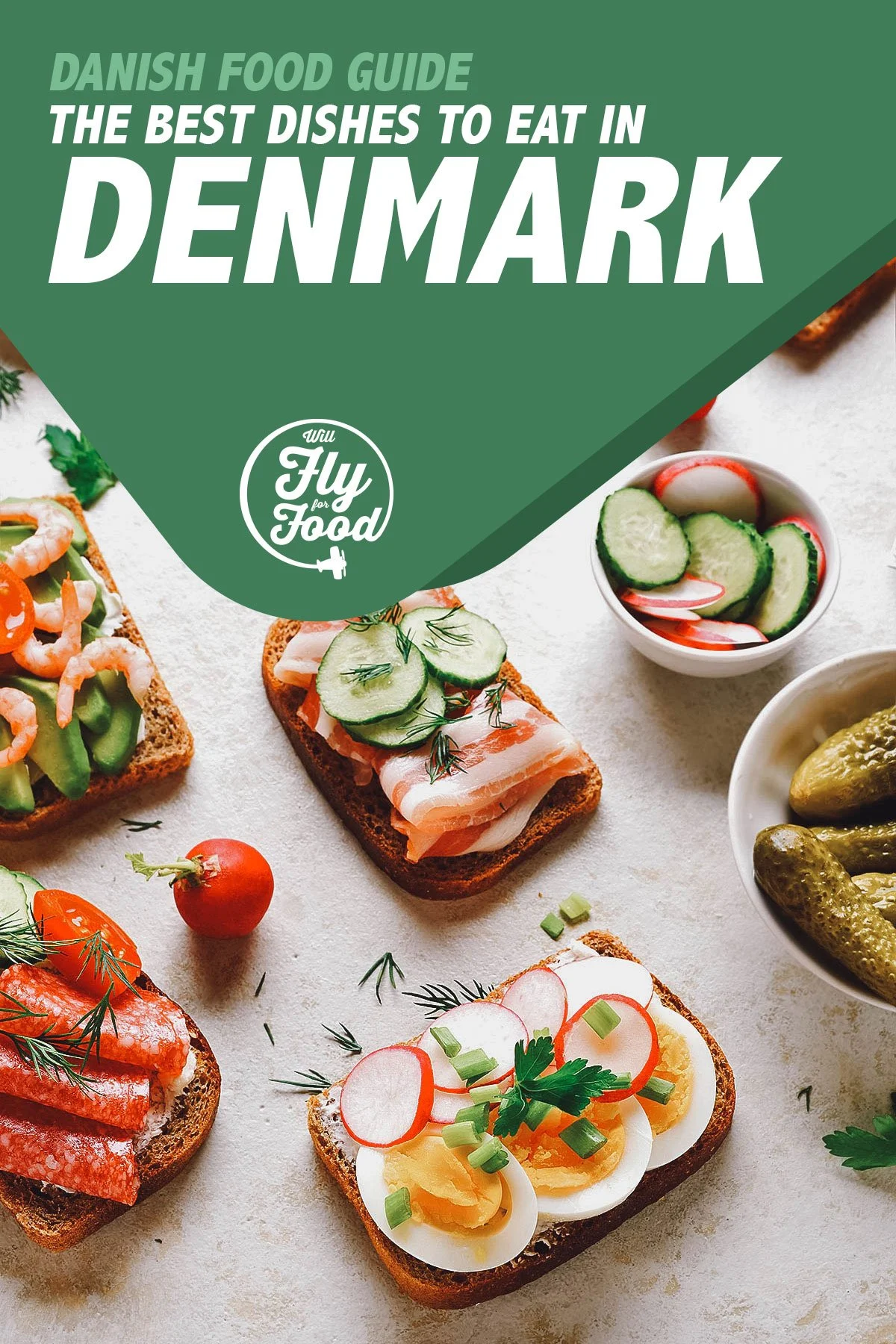
Photo by voltan1
WHAT IS TRADITIONAL DANISH FOOD?
Before the Industrial Revolution, traditional Danish food was heavily reliant on local produce. Families lived on bread, fish, pork, and potatoes and kept a storage of long-lasting food products like rye, barley, dried peas, and salted pork.
With rapid industrialization came an increase in the consumption of fresh meat, vegetables, and milk. The introduction of wood-burning stoves and meat grinders led to the creation of new dishes like Danish meatballs, sausages, and breaded pork patties. Thanks to sausages and rye bread, Danish open-faced sandwiches were invented in the 19th century and became a practical way for factory workers to pack a quick and filling lunch.
By the end of the 20th century, Danes started to travel more widely and became interested in the cuisines of other countries like France and Spain. They adapted these techniques and used local ingredients to transform traditional Danish food into beautifully presented Nordic dishes.
THE BEST TRADITIONAL DANISH DISHES
1. Smørrebrød
There’s no better (or prettier) way to start this Danish food guide than with smørrebrød, Denmark’s artful contribution to the world of sandwiches. A national dish of Denmark, smørrebrød translates to “butter bread” and refers to the endless variety of beautifully crafted Danish open-faced sandwiches.
Open-faced sandwiches have existed in Europe since the Middle Ages but it wasn’t until the onset of industrialization in the 19th century did the smørrebrød tradition take hold in Denmark. Factory workers could no longer return home for lunch so they’d pack open-faced sandwiches made with buttered rye bread topped with smoked fish, cold meats, and the previous night’s leftovers.
The practice caught on and eventually became a part of Danish food culture. Not only did smørrebrød provide a quick and tasty meal, but they were a practical way of recycling leftovers. Over time, smørrebrød became a common sight on holiday tables and could be found on Danish restaurant and pub menus across the country.
Today, Danish smørrebrød can range from the simple to the lavish. It always starts with Danish rye bread (rugbrød) primed with a thin layer of butter or goose fat to keep the bread from getting soggy. A variety of local ingredients are then arranged on top like pickled herring, cold cuts, salmon, shrimp, hard-boiled eggs, fruit, herbs, and microgreens.
Unlike your typical sandwich, smørrebrød is never eaten by hand. They’re eaten with a knife and fork and always in the proper order. When sampling a variety of toppings, herring is always eaten first, followed by other types of seafood, meat, and then cheese.
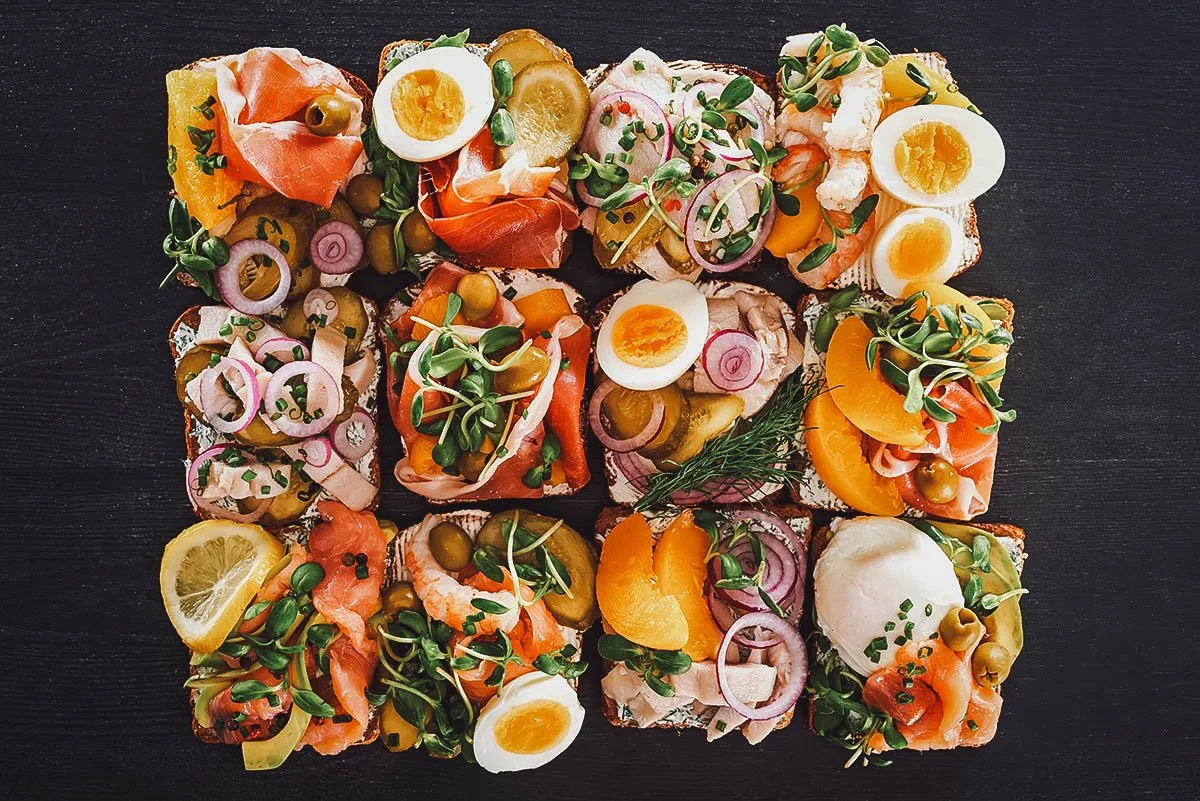
Photo by VadimVasenin
There are hundreds of varieties and combinations of smørrebrød but stjerneskud is one of the most well-known. A common sight at Danish restaurants and cafes, it’s made with buttered rye bread topped with a fried fish fillet, shrimp, caviar, asparagus, dill, and lemon. Stjerneskud means “shooting star” in Danish.
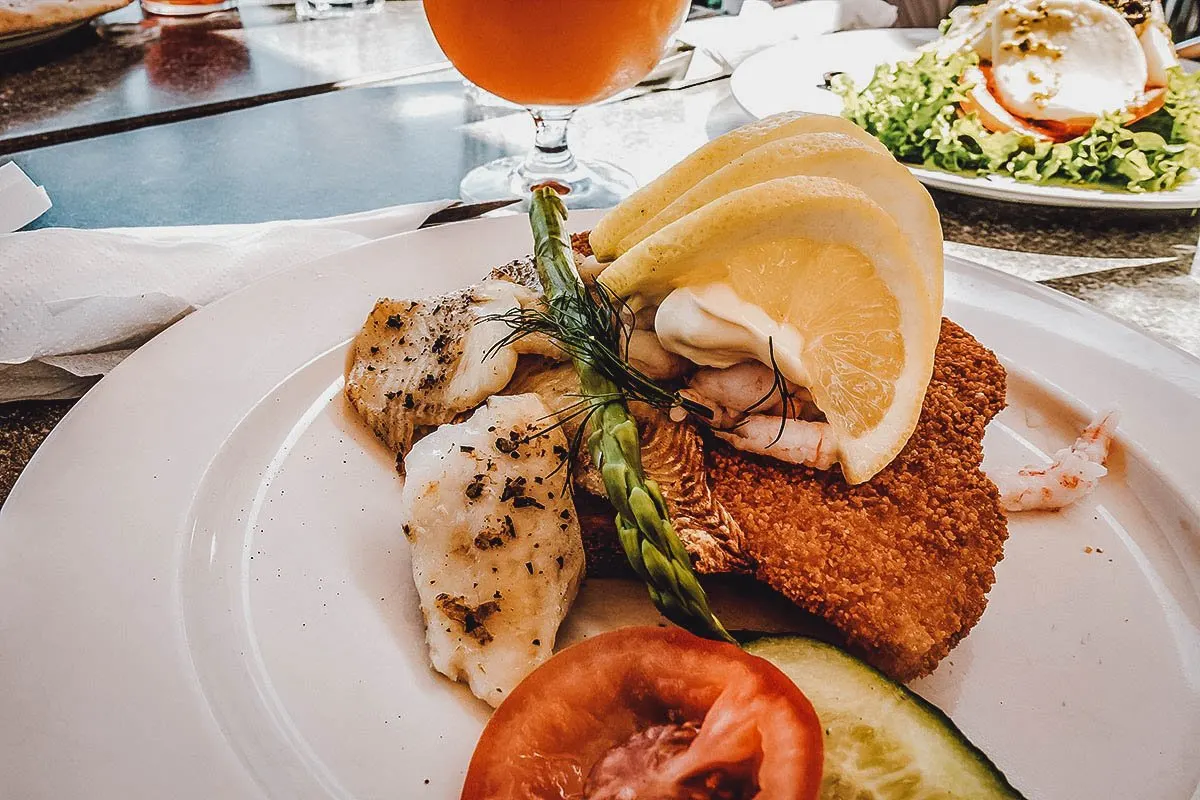
Photo by aallm
2. Tarteletter
Tarteletter refers to an old and very traditional Danish dish made with pre-made puff pastry shells filled with different ingredients. The tartlets are typically store-bought and can be filled with various meats, seafood, and vegetables, though one of the most popular versions is filled with chicken and asparagus in a creamy white sauce made with flour, butter, and milk.
This Danish appetizer or snack has been around since the 19th century though it has waned in popularity in recent decades. In modern times, tarteletter is viewed largely as old-school Danish food served mostly at restaurant buffets and special-occasion brunches.
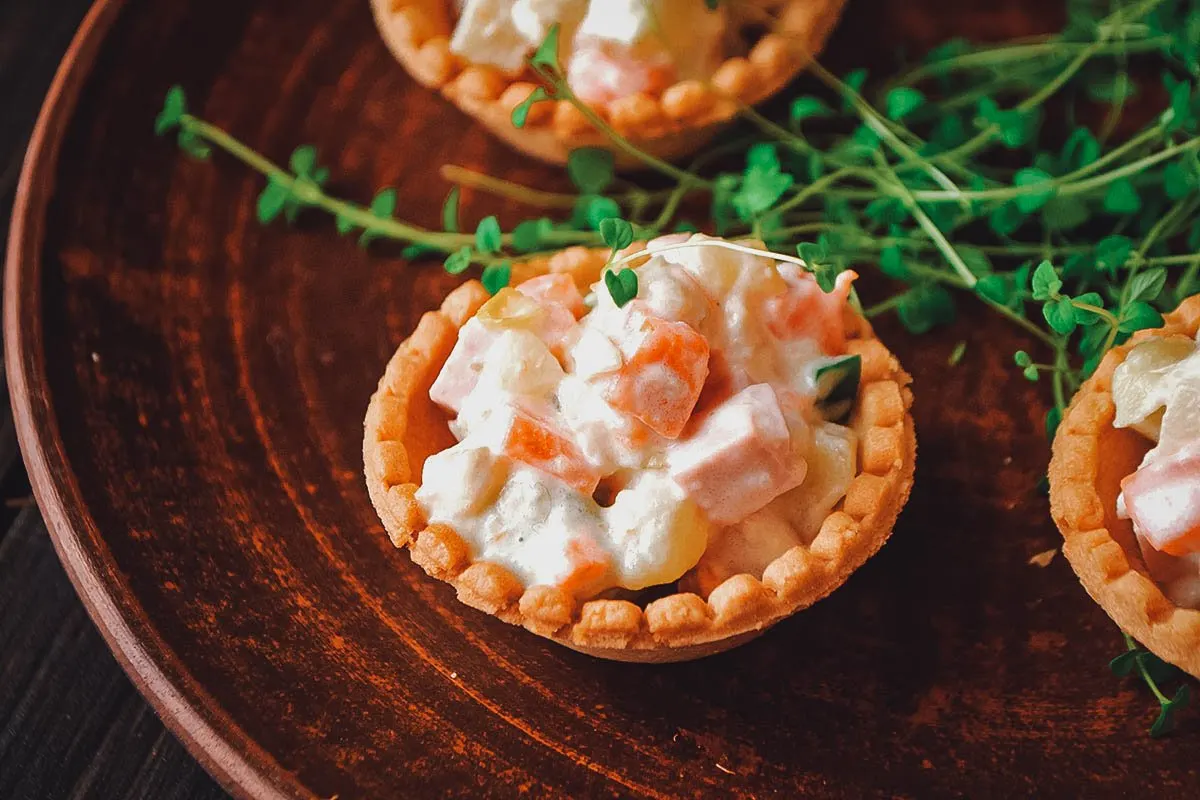
Photo by annafrby
3. Pickled Herring
If you’re familiar with Northern European cuisine, then the inclusion of pickled herring in this Danish food guide should come as no surprise. It’s an important part of the cuisines of many countries in the region like Denmark, Iceland, Norway, Finland, Sweden, and the Netherlands.
Pickled herring refers to herring that’s been preserved through pickling or curing. Fresh herring is first cured with salt to extract water before being brined in a solution containing vinegar, salt, sugar, onions, and spices. Depending on the recipe, it can be flavored with other ingredients as well like sherry, mustard, lemon, and dill.
In Denmark, pickled herring can be enjoyed in many ways though one of the most popular uses is to serve it over dark rye bread in smørrebrød.
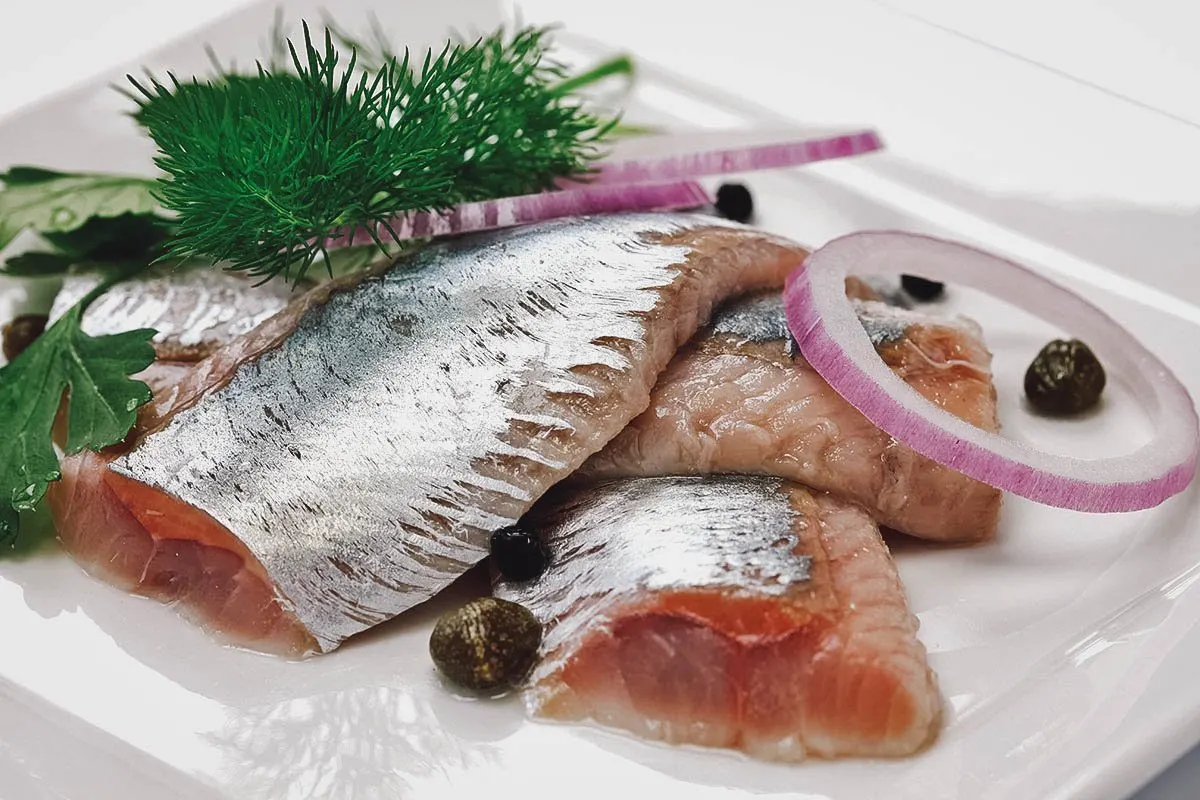
Photo by asimojet
4. Rugbrød (Rye Bread)
Rugbrød refers to an everyday type of rye bread in Denmark. Dense, dark, and a bit sour in flavor, it forms an essential part of Danish cuisine and is used as the base for smørrebrød open-faced sandwiches.
Recipes for rugbrød vary but it’s typically made with a sourdough starter, dark rye flour, wheat flour, cracked rye, and other seeds like flaxseeds, sunflower seeds, or pumpkin seeds. Ale or beer is often mixed into the dough which is typically allowed to ferment for 24-48 hours, depending on the desired level or sourness.
Because it contains no added oils or fats and is made with little to no sugar, rugbrød is considered a very healthy type of bread. It’s low in fat and rich in whole grain and dietary fiber.
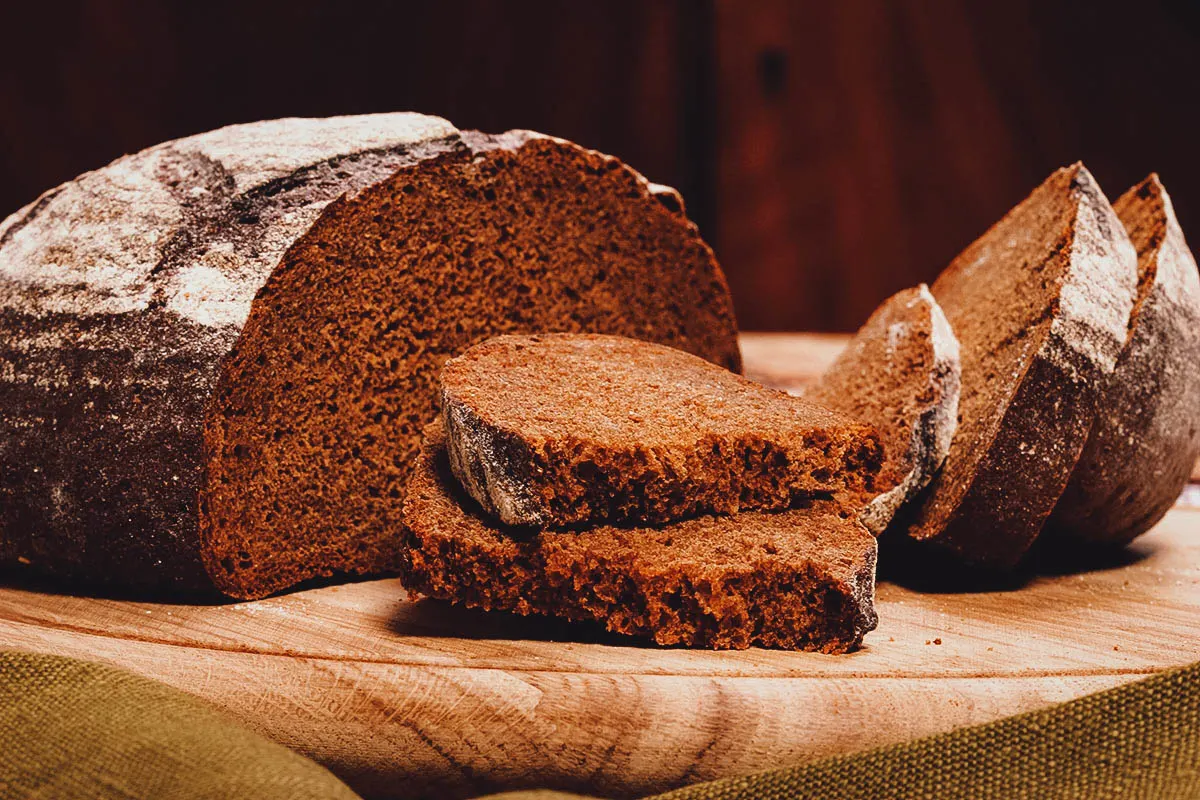
Photo by spotty
5. Frikadeller
If you like meatballs, then you’re going to love frikadeller. It refers to the Danish version of pan-fried meatballs that’s also popular in the cuisines of Poland and Germany.
Danish meatballs are typically made with minced veal, pork, or beef mixed with onions, eggs, milk, bread crumbs, salt, and pepper. The mixture is formed into balls which are slightly flattened and then pan-fried in butter, margarine, or vegetable oil. They’re often served as a main course or side dish, often with boiled white potatoes and cooked red cabbage.
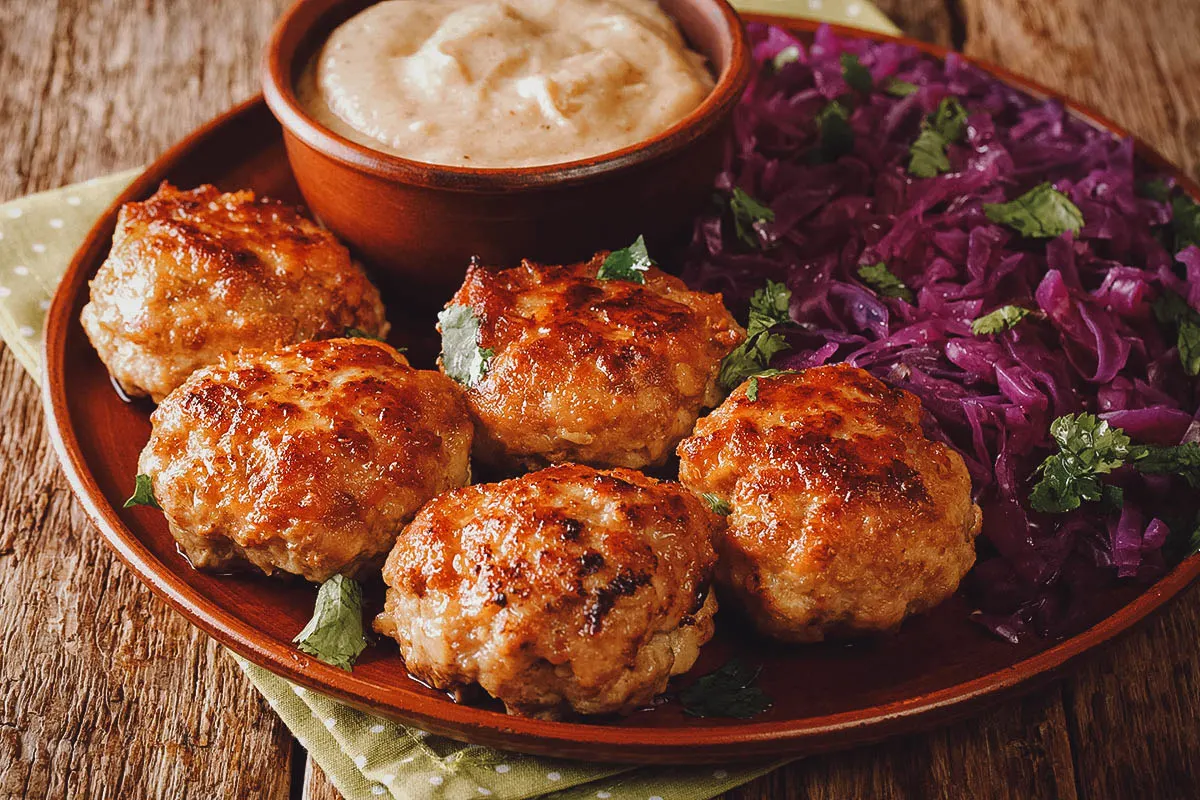
Photo by lenyvavsha
If you don’t eat meat, then perhaps you’d like to try fiskefrikadeller instead. It refers to a type of frikadeller made with fish instead of meat. It’s usually made with cod or salmon and served with remoulade.
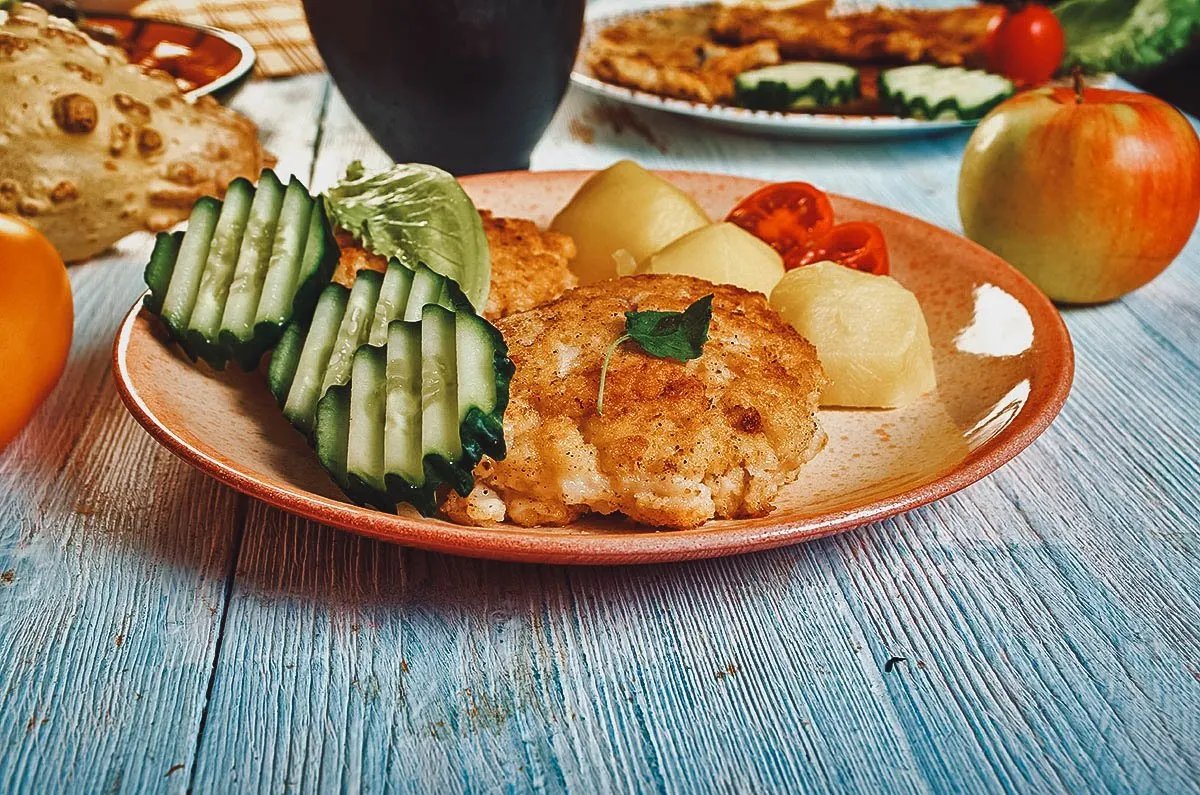
Photo by fanfon
6. Pølse
If you think that hot dog stands are ubiquitous only in America, then you’re wrong. The pølse or Danish hot dog is one of the most popular street foods in Denmark. It’s sold and eaten everywhere – on ferries, at gas stations, and from mobile hot dog stands known as pølsevogn (meaning “sausage wagon”).
In the US, the term “hot dog” that can refer to both the sausage and the sandwich (hot dog in bun) but in Denmark, a sausage can only be referred to as “pølse” when it’s served in a bun. Otherwise, it’s just a sausage. Pølser are so popular in Denmark that it’s considered by many to be a Danish national dish.
There are two types of pølse in Denmark – classic Danish røde pølse (red sausage) and the brown grillpølse (grilled sausage). Røde pølser are the more common of the two. They’re typically beechwood-smoked and served with remoulade, ketchup, mustard, fried onions, and gherkins.
According to legend, røde pølser became popular in the 1920s when hot dog vendors would dye day-old sausages red to indicate their lack of freshness. They did so so they could sell them at a lower price.
Today, an estimated 100 million pølser are sold in Denmark each year. That’s a staggering number considering Denmark has a population of just 5.8 million!
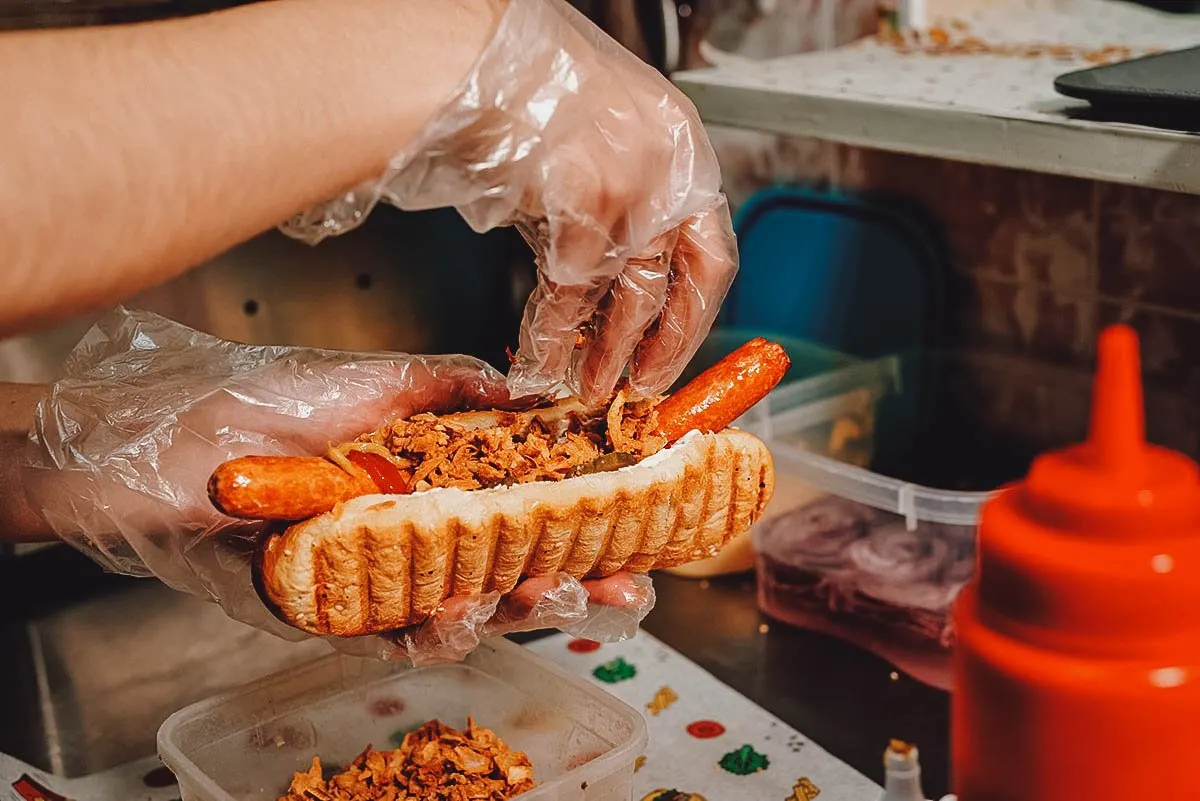
Photo by valdaar.mail.ru
7. Medisterpølse
Medisterpølse (or medister, medisterkorv) refers to an aromatic and slightly sweet Danish sausage made with spiced minced pork, suet, chopped onions, and various spices like cloves, allspice, salt, and pepper. It’s typically boiled for a few minutes and then fried in butter before being served with plain boiled or steamed potatoes, pickled beets, and a thick brown gravy.
For the most satisfying experience, try it with a cold bottle of traditional Danish beer like Carlsberg or Tuborg.
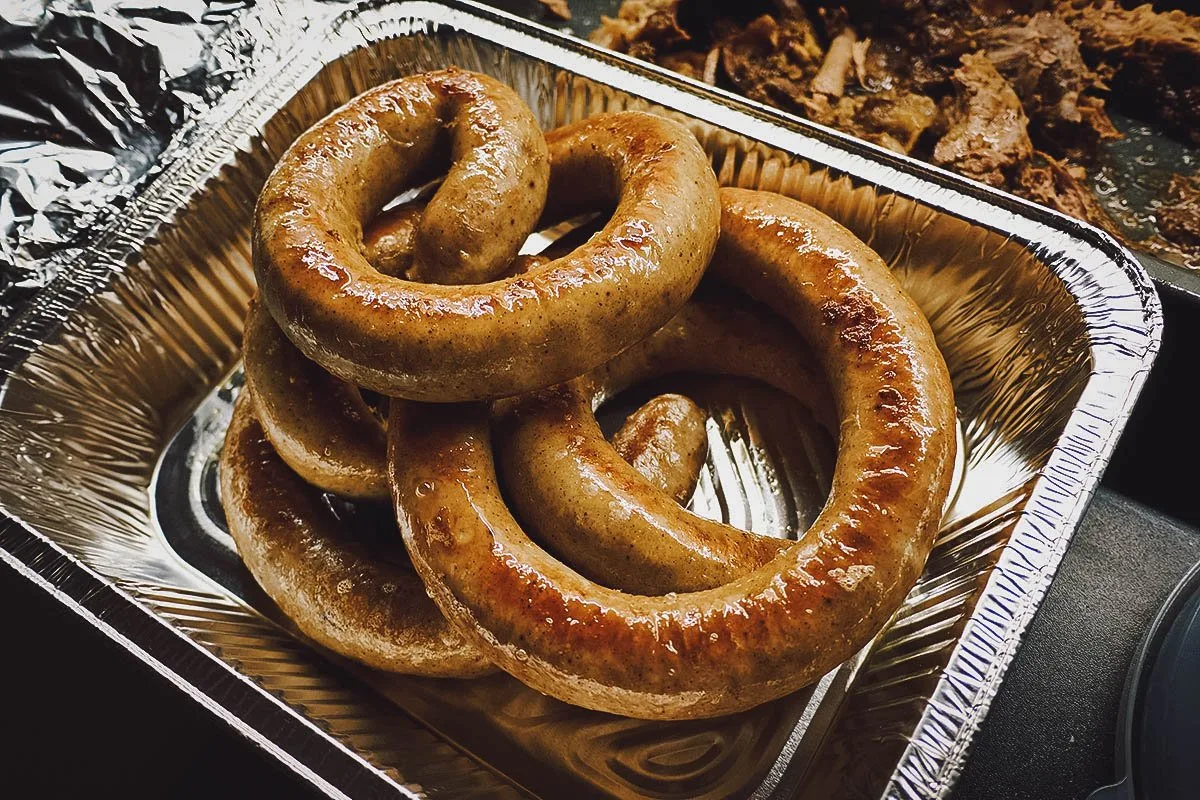
Photo by ronyzmbow
8. Flæskesteg
In many countries around the world, the most delicious dishes are often reserved for Christmas dinner and Denmark is no exception. This scrumptious-looking dish with crispy pork skin is called flæskesteg, the Danish version of roast pork.
Flæskesteg is a traditional Danish dish that’s always served on Christmas Eve. Outside of a few minor variations, every Danish family pretty much serves the same dishes to celebrate Christmas – goose, roast duck, and pork roast with crackling skin. It’s been a beloved Danish Christmas tradition for well over a hundred years.
To make flæskesteg, a cut of pork with the rind still attached is sliced through the skin in narrow strips. The skin is then rubbed with salt, pepper, bay leaves, and cloves before being roasted in an oven. When the skin bubbles up and becomes crispy, the pork roast is ready to serve.
Flæskesteg is often enjoyed with boiled white potatoes, caramelized potatoes, pickled red cabbage, pickled cucumber, and gravy.
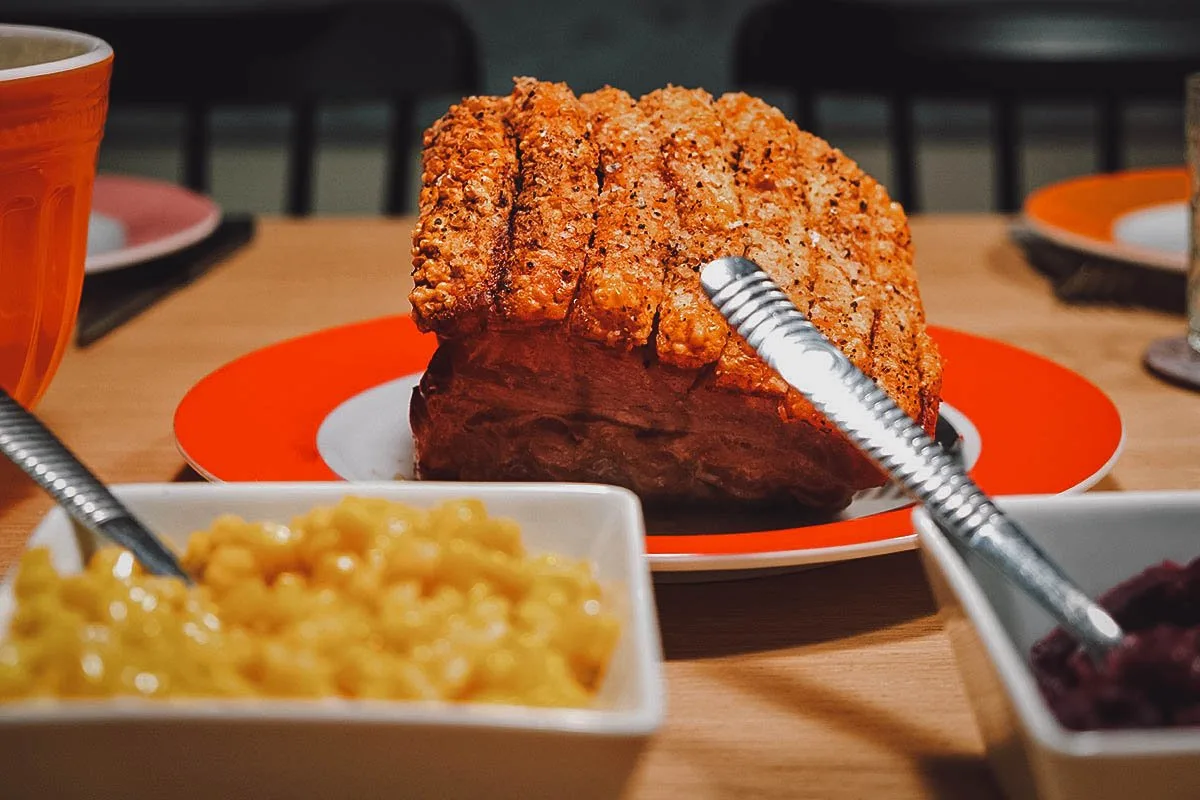
Photo by Johann
9. Stegt Flæsk med Persillesovs
Danes eat a lot of pork. It’s the most popular type of meat in Denmark and used to make many delicious Danish dishes like flæskesteg, pølse, and leverpostej (pork liver pate). If you like bacon, then one of your favorites will surely be stegt flæsk.
Stegt flæsk med persillesovs literally means “fried pork with parsley sauce” and refers to a popular Danish dish made with fried pork belly served with boiled potatoes and parsley sauce. Often fried till crispy, flæsk is very similar to bacon except it’s usually unsalted and never smoked.
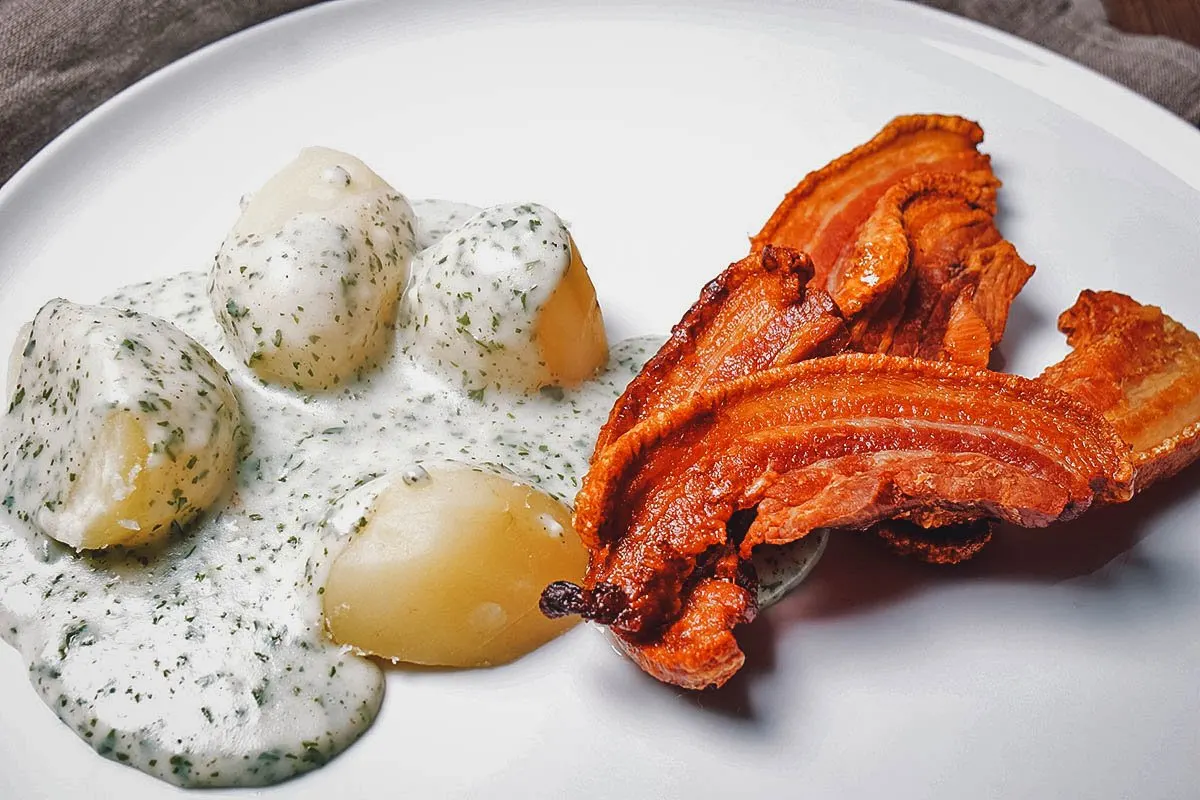
Photo by PantherMediaSeller
10. Grydestegt Kylling
Grydestegt kylling refers to a traditional Danish dish made with pot-roasted chicken cooked with butter and parsley. It’s an old-fashioned but comforting dish that’s usually served with boiled potatoes, cucumber salad, rhubarb compote, and gravy.
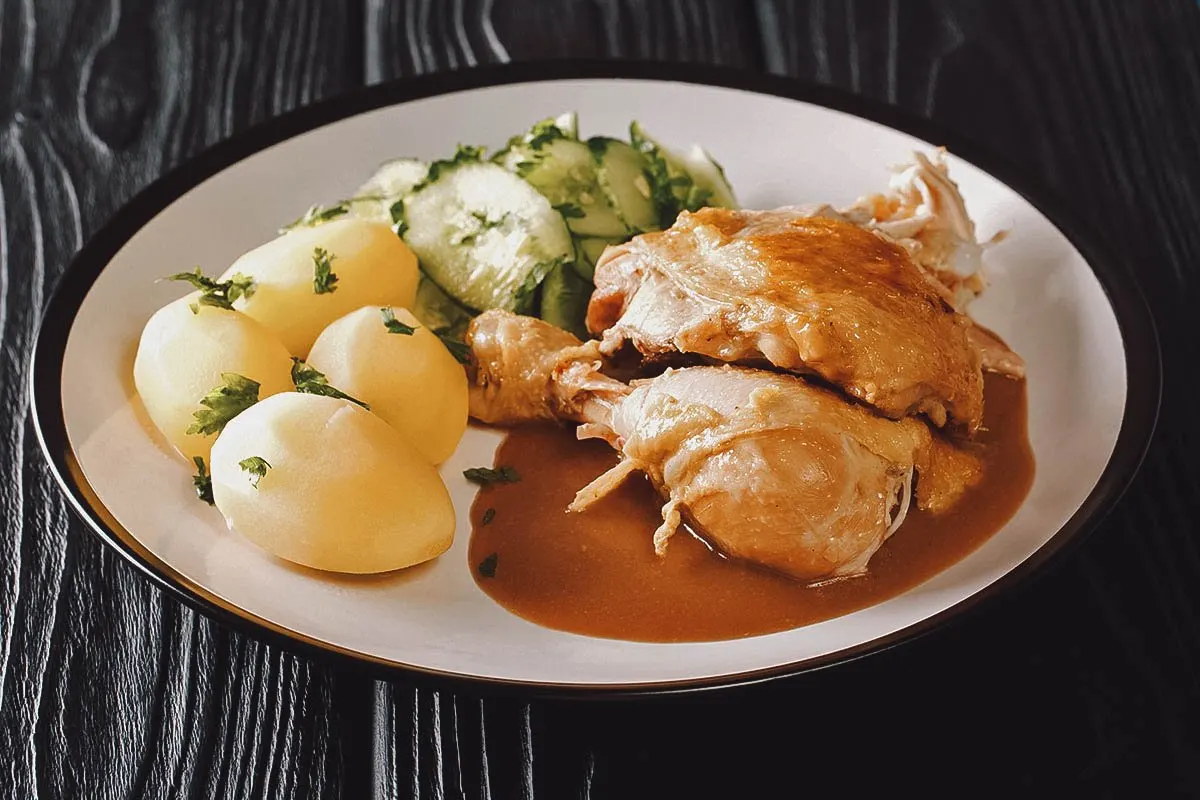
Photo by lenyvavsha
11. Æblekage
Æblekage literally means “apple cake” though it refers to a traditional Danish dessert that’s closer in appearance to a trifle. Typically served in a glass or transparent bowl, it’s made with layers of apple puree, apple cake crumble, Danish macaroons, and whipped cream.
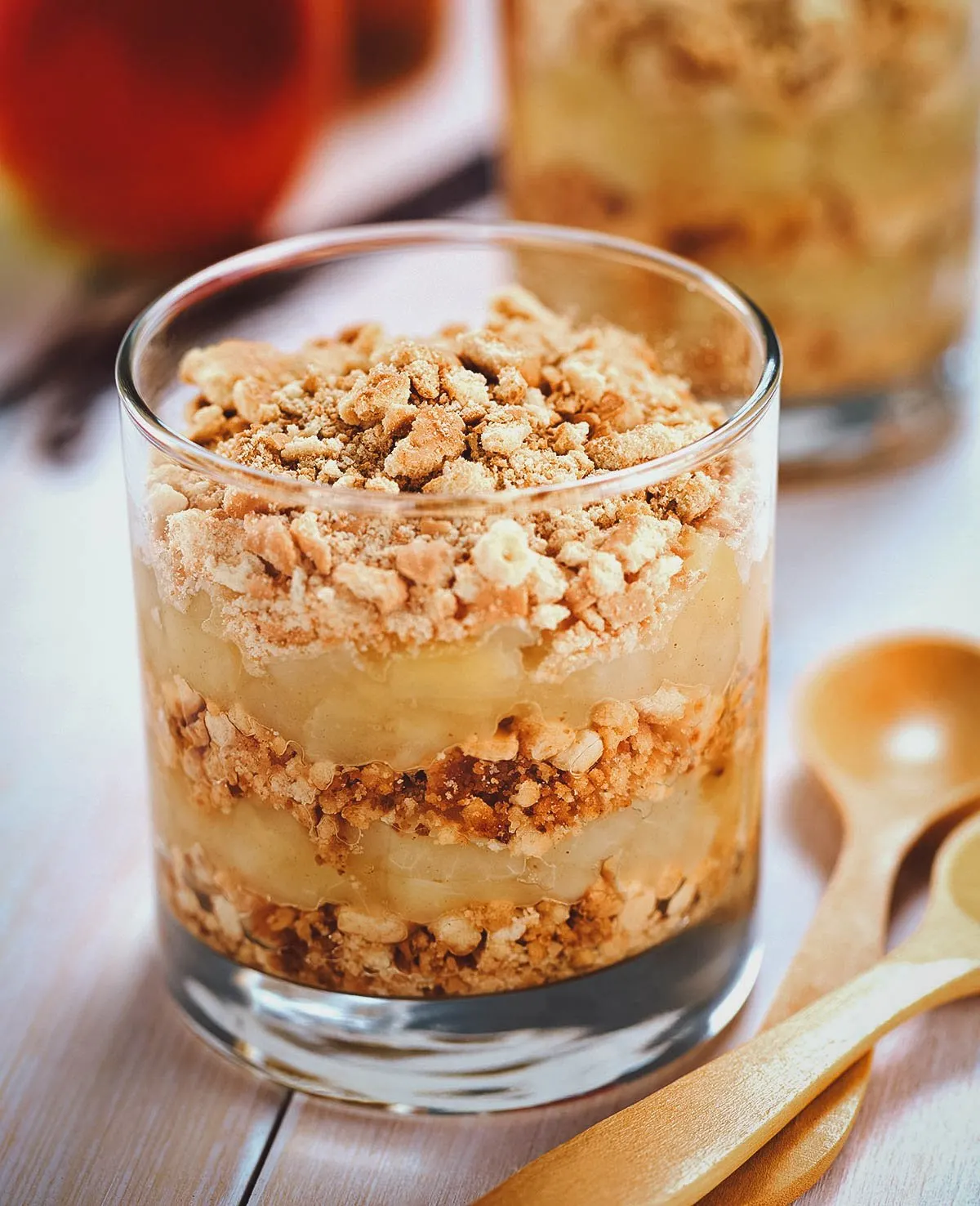
Photo by ildi_papp
12. Wienerbrød
Like smørrebrød, wienerbrød is one of the most well-known dishes in Danish cuisine. Known simply as “Danish” outside of Denmark, it refers to a family of Danish pastries made with laminated dough and a variety of fillings like cream, jam, nuts, cheese, and fruit preserves.
The term wienerbrød translates to “Viennese bread” and is believed to be in reference to the Austrian bakers who brought the technique of laminating bread to Copenhagen. According to the story, a bakery workers’ strike in mid-19th century Denmark led to the hiring of Austrian bakers who brought with them techniques and recipes that led to the creation of wienerbrød.
Today, they’ve become a major part of Danish gastronomy with the average Dane consuming an estimated 10 kilos (22 lbs) of pastries and cakes each year. If you’re like most people and have a fondness for sweet flaky pastries, then be sure to try some of these delicious examples of wienerbrød on your next trip to Copenhagen:
Spandauer: This is the classic version of the pastry and what inspired the globally recognized “Danish”. Its name is derived from a prison in Berlin’s Spandau district, which according to Danish bakers, resembles the form of the pastry.
Kanelsnegle: The Danish equivalent to a cinnamon bun. Interestingly, there’s a Danish tradition called Onsdagssnegle that calls for people to eat cinnamon buns on Wednesdays.
Frøsnapper: Danish pastry filled with remonce, a thick paste made with butter and sugar. It’s less sweet than other pastries thanks to salt and a liberal dusting of poppy seeds, sesame seeds, and linseeds.
Tebirkes: Folded pastry filled with remonce and topped with poppy seeds. It’s similar to frøsnapper except it’s folded instead of stretched and twisted.
Pølsehorn: The Danish rendition of a pig in the blanket.

Photo by elenathewise
Pictured below is kanelsnegle, the Danish equivalent to the popular cinnamon bun. The name kanelsnegle literally means “cinnamon snail”.
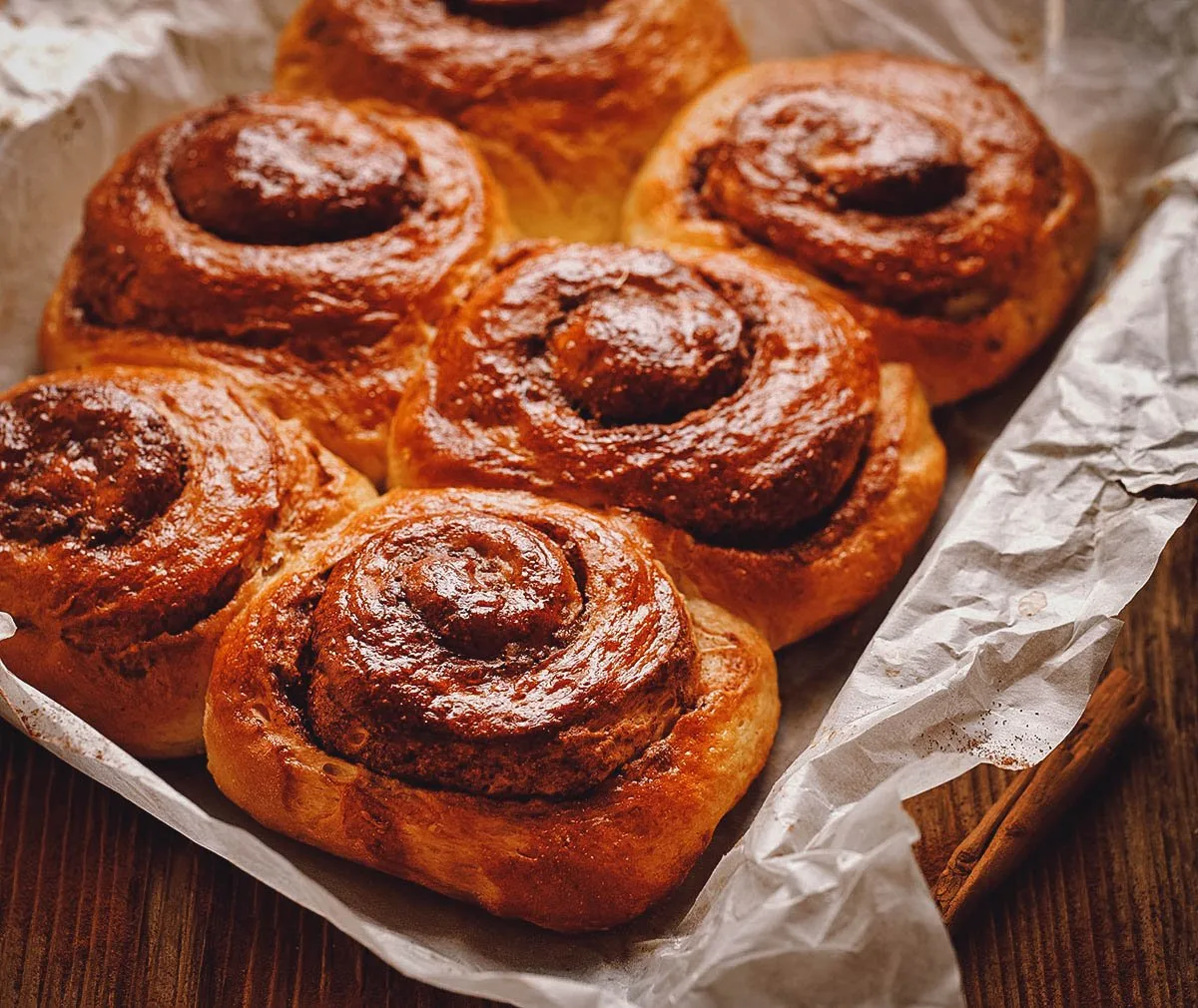
Photo by zi3000
DANISH FOOD TOURS
Needless to say, no one knows traditional Danish food better than a local, so what better way to experience the best of Danish cuisine than by going on a food tour? Not only will a local guide take you to the city’s best markets and restaurants, but they can explain all the traditional Danish dishes to you in more detail as well. Check out Get Your Guide for a list of Danish food tours in Copenhagen and other cities throughout Denmark.
FINAL THOUGHTS ON TRADITIONAL DANISH CUISINE
Without question, modern Danish gastronomy is exciting, but there’s also much to love about the traditional food in Denmark. It’s simple and hearty fare that’s meant to comfort and fill you up.
Traveleaters with a taste for haute cuisine will have much to be excited about in Denmark. But be sure to leave room for dishes like pølser and stegt flæsk as well. I’m sure you’ll find them to be just as memorable and satisfying.
Disclosure
Some of the links in this Danish food guide are affiliate links, meaning we’ll earn a small commission if you make a booking or reservation at no extra cost to you. As always, we only recommend products and services that we use ourselves and firmly believe in. We really appreciate your support as it helps us make more of these free travel and food guides. Thank you!
Cover photo by maxsol7. Stock images via Depositphotos.


Abigail Hall
Tuesday 19th of April 2022
I looked it up and fish is a meat
JB & Renée
Wednesday 27th of April 2022
@Abigail: You mean I've been sinning all those Good Fridays? Dammit.
Brooklynn
Tuesday 12th of April 2022
these look amazing, these dishes look wonderful. I cant wait to try some of these amazing dishes
JB & Renée
Tuesday 12th of April 2022
Go for it Brooklynn!